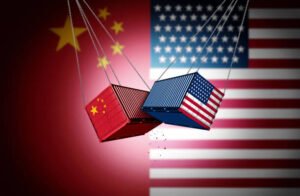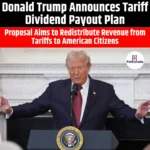Trump Imposes Additional 100% Tariff on Chinese Imports
|
General Studies Paper II: Impact of Policies and Politics of Countries on India’s Interests |
Why in News?
On October 10, 2025, President Donald Trump announced a significant escalation in the U.S.-China trade conflict by imposing a 100% tariff on all Chinese imports, effective November 1, 2025 or sooner, depending on China’s actions.
Reasons Behind the 100% Tariff Announcement on Chinese Imports
- China’s Expanded Export Controls: On October 9, 2025, China announced the expansion of its export controls on rare earth elements, adding five new materials—holmium, erbium, thulium, europium, and ytterbium—to its existing list. These elements are crucial for manufacturing electric vehicles, aerospace equipment, and military technology. The new regulations require exporters to obtain licenses, with China signaling it will reject those tied to defense applications and closely assess uses in semiconductors and advanced AI.
- U.S. National Security Concerns: In response to perceived national security threats, the U.S. Federal Communications Commission (FCC) has removed millions of listings for Chinese electronic products, including security cameras and phones from companies such as Huawei and ZTE. These companies are either on a U.S. Restricted List or lack proper FCC authorization. The crackdown is part of ongoing efforts by U.S. agencies to mitigate national security risks posed by Chinese tech firms across sectors like telecommunications and semiconductors.
- China’s Retaliatory Port Fees: Trump and Chinese President Xi Jinping, China announced new retaliatory port fees on U.S.-linked vessels. Beginning October 14, American-owned, operated, built, or flagged ships docking in China will be charged 400 yuan ($56) per net ton per voyage, with the charge increasing annually until reaching 1,120 yuan ($157) by 2028. Each vessel will be charged for up to five voyages per year. This move mirrors the U.S.’s planned fees of $50 per net ton on Chinese vessels, set to begin the same day, increasing by $30 per year until 2028.
- Previous Tariff Increases: The U.S.-China trade war has been intensifying throughout 2025. In February, President Trump increased tariffs on China. In April, Trump raised tariffs on China by another 34%, after accusing China of tariff and non-tariff trade barriers of 67%. China responded with retaliatory tariffs of 84% on U.S. goods. These escalating measures have contributed to the decision to impose additional tariffs.
Impact of the US-China Trade War
- Global Economic Slowdown: The escalating trade tensions between the United States and China have significantly impacted the global economy. In 2025, the World Bank revised its global growth forecast downward to 2.3%, a decline from 2.8% in 2023 and 2024. This slowdown is attributed to the ongoing trade war, which has disrupted global trade and economic activities.
- Disruption of Global Supply Chains: Countries dependent on Chinese manufacturing or U.S.-designed technologies are facing cross-border economic shocks. Reshoring and near-shoring efforts are expensive and time-consuming, making it challenging for businesses to adapt quickly. The trade war is reshaping global supply chains, with companies reevaluating their sourcing strategies to mitigate risks associated with the ongoing tensions.
- Inflationary Pressures: A tariff-heavy regime risks pushing up the prices of everyday goods, fueling inflation and potentially curbing consumer spending. The imposition of tariffs on Chinese imports increases the cost of goods, which may be passed on to consumers in the form of higher prices. This inflationary pressure can reduce consumer purchasing power, leading to decreased demand for goods and services.
- Geopolitical Polarization: The ongoing trade war is forcing countries to choose sides, undermining multilateralism and fragmenting global economic governance. As the U.S. and China engage in tit-for-tat measures, including tariffs, export controls, and trade blacklists, other nations are being pressured to align with one side or the other. This geopolitical polarization can lead to a fragmented global economic system.
Implications of the US-China Trade War on India
- Supply Chain Disruptions: India’s electronics, automotive, and pharmaceutical industries heavily rely on Chinese components. The imposition of tariffs on Chinese goods has disrupted these supply chains, leading to increased costs and delayed shipments. For instance, the Indian electronics sector faces challenges in sourcing components like semiconductors and display panels, which are predominantly imported from China.
- Pharmaceutical Sector: Approximately 70% of Active Pharmaceutical Ingredients (APIs) used in Indian medicines are imported from China. The trade war has led to tariff-linked cost hikes and supply bottlenecks, raising concerns about the availability and affordability of essential medicines. These challenges threaten India’s position as a leading exporter of generic drugs.
- Economic Growth: The US-China trade war has weakened global demand, slowing India’s GDP growth. For example, in 2019–20, India’s GDP growth fell to 4.2%, partly due to the trade war’s impact on global trade flows. These pressures have increased household spending and business costs. This combination of slower growth and higher inflation poses challenges for India’s economic stability.
- Policy Responses: In response to the trade war’s challenges, India is exploring strategic realignments and policy responses. The government is diversifying trade partnerships, focusing on markets like Japan, South Korea, and the UK. The India-UK Comprehensive Economic & Trade Agreement (CETA), signed in May 2025, aims to eliminate tariffs on 99% of Indian exports to the UK.
Strategies to Navigate the US-China Trade War
- The World Trade Organization’s Appellate Body has been inactive since 2019. Countries must collaborate, especially G20 and Quad members, to revive the WTO’s dispute settlement system. This will provide a structured platform to resolve large-scale trade conflicts and prevent unilateral actions from destabilizing global trade.
- Developing nations should reduce dependence on the US-China trade axis by investing in South-South trade networks. India-Africa, India-ASEAN, and India-Latin America corridors can diversify sourcing and markets. This approach spreads risk and increases resilience against disruptions from major trade conflicts.
- Europe strengthening ties with Asia can decentralize global trade away from US dominance. Bilateral and multilateral agreements between EU countries and Asian economies can facilitate investment, technology exchange, and supply chain diversification.
- Platforms like APEC, BRICS, and G20 must prioritize economic cooperation over unilateral actions. Member nations should focus on dialogue, shared standards, and coordinated trade policies. This approach can reduce tensions and protect smaller economies.
|
Also Read: U.S.-China Trade Agreement 2025 |










